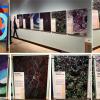Emergence of Movement Sensitive Neurons' Properties by Learning a Sparse Code for Natural Moving Images
Olshausen & Field demonstrated that a learning algorithm that attempts to generate a sparse code for natural scenes develops a complete family of localised, oriented, bandpass receptive fields, similar to those of 'simple cells' in V1. This paper describes an algorithm which finds a sparse code for sequences of images that preserves information about the input. This algorithm when trained on natural video sequences develops bases representing the movement in particular directions with particular speeds, similar to the receptive fields of the movement-sensitive cells observed in cortical visual areas. Furthermore, in contrast to previous approaches to learning direction selectivity, the timing of neuronal activity encodes the phase of the movement, so the precise timing of spikes is crucially important to the information encoding.
